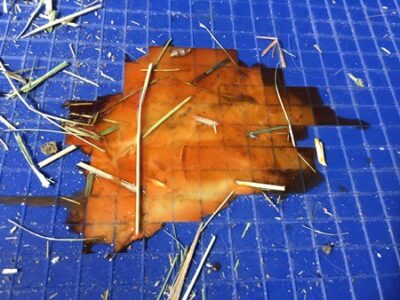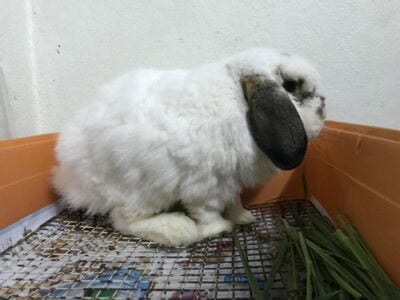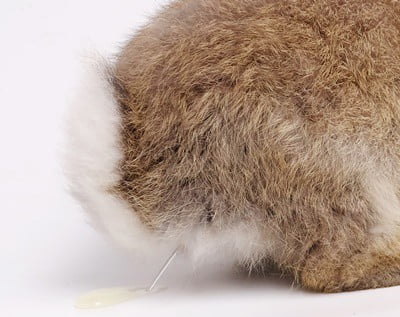In an ideal world, rabbit pee will always be a shade of yellow. But there’s no such thing as one set healthy color for rabbit urine. Rabbit pee changes color constantly. Factors including diet, hydration, and stress levels influence the appearance and consistency of rabbit wee.
As long as rabbit pee is clear, your rabbit is healthy. Cloudy or chalky urine of any color is a sign that your rabbit has too much calcium in her blood. Red rabbit urine is rarely related to blood, but diluted pink urine and/or specks of red can be a sign of hematuria.
Your rabbit’s pee shouldn’t change shade regularly. Beyond this, focus more on the consistency of the urine than the color. The most important thing is that the urine is clear, and easily passed.
What is a Healthy Rabbit Pee Color?
Cloudy urine is an early warning sign of excessive calcium in your rabbit’s diet. If you modify your rabbit’s diet at this stage, there will be no damage. If you ignore cloudy urine, it will eventually become sludgy and chalky.
You rarely need to be concerned if your rabbit’s urine is red. While it’s natural to assume that this is blood, this may not be the case. It’s likelier to be pigmentation from your rabbit’s bladder.
Don’t ignore strange colors of urine in your rabbit’s litter box. If her pee is a peculiar color for a prolonged period, take your rabbit to the vet. If it changes regularly, it’s natural.
Rabbit Urine Color Chart
Rabbit pee has a wide array of colors, as Greendale Veterinary Diagnostics explains. Don’t be surprised if your rabbit urinates in different colors throughout the day. The chart below will summarize the meaning of different pee shades:
| Bright Yellow | Bright yellow urine means that your pet is healthy. It is eating and drinking well, and seemingly has no health concerns. |
| Milky Yellow | Rabbit urine that’s a milky yellow shade is the first warning of calciuria. Your rabbit’s urine may also appear to be a milky white in this case. Change your rabbit’s diet. If it eats alfalfa hay, switch to timothy or meadow hay. |
| Red | Red urine is a result of pigments in your rabbit’s bladder. Certain foods and plants can cause this, as can antibiotics. Even cold weather, when it arrives suddenly, can cause red pee. If its urine remains red for several days, this is unusual. |
| Pink | Pink urine suggests that your rabbit may have traces of blood in its pee. The blood being diluted by urine causes this pink shade. There is a chance this is caused by something your rabbit ate, such as strawberries or cranberries. Excess dietary calcium could be to blame. |
| Brown | Bladder pigments usually cause brown urine. If the shade of brown is deep and rusty, refer to the segment on red urine. Double-check that your rabbit is not constipated. If it has an intestinal blockage, then fecal matter will back up in its system. Rabbits cannot vomit, so it will not be cleared this way. |
| Orange | If your rabbit’s pee looks orange, it may be dehydrated. Check that your pet is drinking enough water. If your rabbit is dehydrated, its urine becomes much more concentrated. Pigments staining your pet’s urine may also cause this shade. |
| White | If your rabbit’s urine is transparent, it’s likely just been drinking a lot of water. Excessive water consumption can be a sign of kidney problems in rabbits. |
The best way to review your rabbit’s urine is to use a white litter. This way, the urine will visibly stain the litter. It’s much easier to determine the color of urine from this than hay.
My Rabbit’s Urine Comes Out as Sludge
Urine sludge often means that your pet has calciuria. This is a health complaint brought on by the excessive consumption of calcium. If left untreated, calciuria can be dangerous to rabbits.
When your rabbit consumes calcium, the kidneys filter it. Anything deemed excess is passed as urine. Rabbits need calcium for strong teeth and bones, but only in small amounts.
Too much calcium thickens up inside your rabbit’s body. This is why her pee is so thick. The first warning sign is cloudiness, or traces of chalky residue.
If your rabbit has this issue, you can treat it at home. It mainly involves dietary changes:
- Stop feeding your rabbit pellets. These are made from alfalfa, which is high in calcium and low in fiber.
- If your rabbit eats alfalfa hay, remove this from her hutch. Adult rabbits do not need this hay. Your pet can eat unlimited amounts of timothy or meadow hay, so use this instead.
- Be mindful of high-calcium fruits and vegetables. Lettuce, spinach, kale, and soybeans should be fed sparingly. Never combine two or more of these ingredients in the same serving.
- Encourage your rabbit to exercise more. This will give her kidneys a kick start, and help them filter out excess calcium effectively. This minimizes the risk of internal damage.
If you follow these steps, your rabbit’s urine should return to normal. This depends on how severe the calciuria is, though. In some cases, your rabbit’s pee may have hardened inside her urinary tract. This causes cystitis and bladder stones.
These health complaints are painful for rabbits. Bladder stones can cause a blockage. A vet will prescribe a course of antibiotics that will quickly clear up the problem.
One other explanation for sludgy urine is dehydration. If your rabbit has not drunk enough water, her body will struggle to eliminate. Encourage your rabbit to drink more. Dehydration can be life-threatening in small animals.

Does My Rabbit Have a UTI?
If your rabbit’s urinary habits seem a little out of the ordinary, she may have a UTI (urinary tract infection). These become more common as a rabbit reaches middle age. This is typically between 3 and 5 years. A UTI is usually the result of a bacterial infection. They can be caused by:
- Obesity. A lack of exercise can also lead to a UTI, especially if your pet rarely leaves her hutch.
- Low-fiber diet. A rabbit that eats more pellets than hay will always be at risk of a UTI.
- Stress. This could be due to a change in routine, or confinement in a hutch that’s too small.
- Excessive calcium, or other vitamins. Be mindful of any supplements you feed your rabbit Mix up her food and treats to ensure she has plenty of variety.
- Unsanitary living conditions. If you don’t clean your pet’s hutch regularly, she’ll wallow in her waste. This attracts bacteria.
- An inability to urinate. This could be a blockage of the urinary tract, such as bladder stones.
A UTI can be painful for your pet. The most common symptoms are:
- Thick, sludgy urine.
- Traces of blood in the urine.
- Incontinence, especially outside the litter box.
- Small dribbles of urine, seemingly constantly.
- Urine scalding around the legs and tail.
- Regular attempts to urinate, without success.
If your rabbit has a UTI, it can be treated with antibiotics. Ensure that the infection is not caused by a more serious condition, though. Sometimes, a UTI is a symptom of another illness.
What Does Blood in Rabbit Urine Mean?
If your pet’s urine is bright red, it’s unlikely to be blood. It’s smaller traces of blood in clear urine that is worrying.
Blood in the urine is known as hematuria. This term refers to entire, intact red blood cells leaving the body through urine. To save time, try to take a urine sample with you to your vet appointment.
Blood in a rabbit’s urine has several explanations. The most common reasons for bloody pee include:
- Kidney stones, or an injury/illness pertaining to the kidneys.
- Bladder stones, cystitis, or crystallization of urine in the bladder.
- Excessive calcium intake.
- Trauma to the genitals.
- Blood clots.
- Issues with the reproductive organs. This is common in unspayed female rabbits of middle age.
- Diabetes
- Cancer
You may also notice physical symptoms in your rabbit before she beings to urinate blood. Watch out for a distended abdomen, an oversized bladder, or bruising around the bladder. These are all warning signs of bladder stones.
Treatment for this issue depends on the underlying cause. If it’s an infection, antibiotics will usually be enough. A more serious health issue may require surgery. If your rabbit has lost a lot of blood through urination, she may need a transfusion. This is rare, but it does happen.

Why Does Rabbit Urine Smell So Bad?
When rabbit urine is left to fester, it produces ammonia. If your pet breathes this in, she could damage her nasal passages and develop snuffles.
Foul-smelling urine is not a sign of ill health in rabbits. You can control the strong scent of your rabbit’s urine by taking the following steps:
- Spay or neuter your rabbit. Fixed rabbits are considered to have weaker-smelling urine.
- Litter train your rabbit, and use an absorbent, rabbit-safe litter in her tray. Avoid scented litter. She will not urinate somewhere that smells bad to her.
- Line your rabbit’s litter box with hay. Rabbits like to eat while going to the toilet. This way, your pet is more likely to restrict her waste to one location.
- Clean and change your rabbit’s litter tray at least once a day. You don’t need to clean the whole hutch this often. Do look out for urine-stained hay and remove this, though. Also, check for any urine under or around the litter tray. Rabbits do not always pee accurately.
- Use white vinegar when cleaning the litter tray. This will remove traces of the scent, as well as any calcium residue. Wash any vinegar from the tray before returning it to the hutch.
Is Rabbit Urine Harmful to Humans?
The smell of rabbit pee is offensive, but not harmful. This suggests that rabbit urine is safe to handle. Rabbit urine does contain one potentially dangerous bug, though.
This is known as Encephalitozoon cuniculi, or E. cuniculi for short. This bug is active in most rabbits. This will not necessarily bother your pet. Many rabbits live with this bug without harm. Their immune system fights it off, and expels it through their urine.
A healthy adult will usually not be affected by E. cuniculi. Children, the elderly or people with an existing sickness will be, though. Any human with limited immunity should not handle rabbit urine.
Pet Care Veterinary Hospital explains how to proceed if you suspect that your rabbit has E. cuniculi. If treatment is required, this will usually take the form of antibiotics. Just be careful when cleaning your pet’s hutch until she is clear of this problem.
If your rabbit’s pee is clear and fluid, it can be considered normal. The color is less important. Always be vigilant about treating cloudy or chalky urine. If left ignored, this will become painful.

